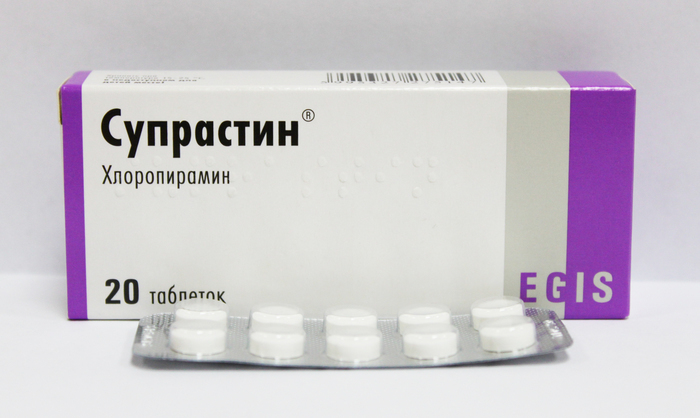Content
- The causative agent of infection, how is infection with dysentery
- Symptoms of a typical form of dysentery
- The incubation period of the disease
- The height of the infection
- Convalescence period
- Symptoms of atypical forms of dysentery
- Features of dysentery in adults
- Features of dysentery in children
- Where and how does the stomach hurt at different stages of dysentery development?
- Mild dysentery
- Moderate form
- Severe form
- Extremely severe form
- How to relieve pain during illness with drugs?
- Traditional methods of pain relief, home remedies recipes
- Features of the regimen and diet to alleviate the condition
- Dysentery video
One of the most common infectious disease is dysenterycharacterized by damage to the gastrointestinal tract. The development of the disease is provoked by bacteria of the genus Shigella. As a result of the destruction of pathogenic microorganisms, toxins are formed, on which the rate of progression of the disease depends. Even in the external environment, disease-causing organisms are characterized by maximum survival rates.
In favorable conditions, bacteria are active from 2 days to 4-5 months. Shigella are capable of active reproduction in food. For example, in various salads, milk, compote, minced meat and steamed fish. With the development of the disease, the patient develops abdominal pain, diarrhea, and intoxication syndrome. Effective treatment in 97% of cases is carried out on an outpatient basis. To normalize the condition, the patient is prescribed antibacterial and detoxification therapy.
The causative agent of infection, how is infection with dysentery
Dysentery is a bacterial infection, the development of which is provoked by pathogenic microorganisms of Shigella, belonging to the enterobacteriaceae family. The disease is diagnosed not only in adults, but also in children.
Experts distinguish between the following types of shigella:
- Shigella flexneri.

- Shigella dysenteriae. Additionally, there are the following subspecies of bacteria: Lorja-Sachs, Grigoriev-Shigi, Shtutser-Schmitz.
- Shigella sonnei.
- Shigella boydii.
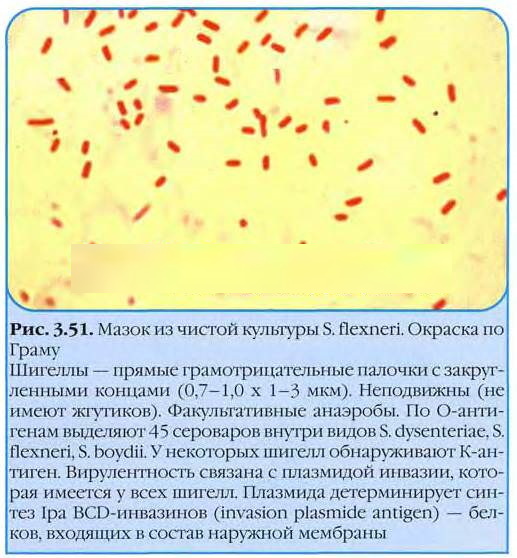
Sources of the causative agent of intestinal infection are bacteria carriers (people in whose body there are pathogenic microorganisms, but they do not affect healthy cells, since the immune system has adapted to the pathogen) and sick dysentery.
The disease is transmitted in the following ways:
- Swimming in polluted water bodies.
- Failure to comply with the rules of personal hygiene. Rare washing and disinfection of hands in everyday life can provoke the development of dysentery, as well as helminthiasis, typhoid fever, salmonellosis and hepatitis A.
- The causative agents of acute intestinal infection can enter the body along with water, food, and also through contaminated household items.
When the first symptoms of dysentery appear, it is extremely important to immediately seek advice from an infectious disease specialist, and not deal with self-medication, as otherwise there is a high risk of complications that can lead to fatal the outcome.
Symptoms of a typical form of dysentery
Abdominal pain with dysentery occurs in 99% of patients who have acquired bacteria of the genus Shigella. The disease can be mild, moderate, or severe. Experts assess the principle of the course of acute dysentery based on the severity of the intoxication syndrome. Additionally, the nature of the inflammatory process in the large intestine is taken into account.
The incubation period of the disease
The initial stage of development of an infectious disease is called latent. The incubation period can last from 2 hours. up to 15 days. It all depends on how much and how the shigella entered the body.
The height of the infection
Within 3 days, the symptoms of dysentery build up extremely quickly. The patient is worried about 2 syndromes at once: intoxication and colitis.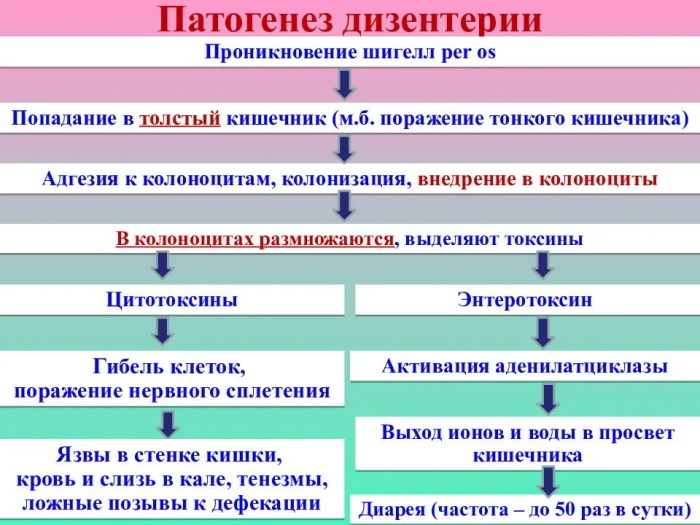
In the first case, the patient experiences the following symptoms:
- Pallor of the skin (cyanosis).
- Increased body temperature.
- Decreased appetite.
With shigellosis, intoxication is short-lived, but vomiting may bother 2 days. It is difficult for specialists to make a correct diagnosis if the symptoms of intoxication occurred earlier than colitis syndrome. The doctor prescribes effective individual therapy only after a comprehensive examination of the patient.
Colitis is characterized by the manifestation of symptoms of acute infection, which is associated with damage to the large intestine.
The diagnosis is quite simple, since the patient has characteristic signs of dysentery:
- Tightness of the abdomen. The patient experiences acute pain on palpation of the intestines.
- Violent rumbling along the colon.
- Abdominal pain that is cramping. The belly hurts above the groin crease on the left side. Discomfort is significantly increased before bowel movements.
- The sigmoid colon becomes dense and inactive. A gaping anus is characteristic.
- The patient experiences frequent urge to defecate. The feces are liquid, streaks of blood and mucus are present. With the rapid progression of an infectious disease, the stool undergoes dramatic changes. During bowel movements, blood-streaked pus is discharged. The pain in the abdomen gradually increases.
- There is a frequent urge to defecate, which is false, which is associated with muscle spasm in the lower part of the large intestine. Rectal prolapse is possible.
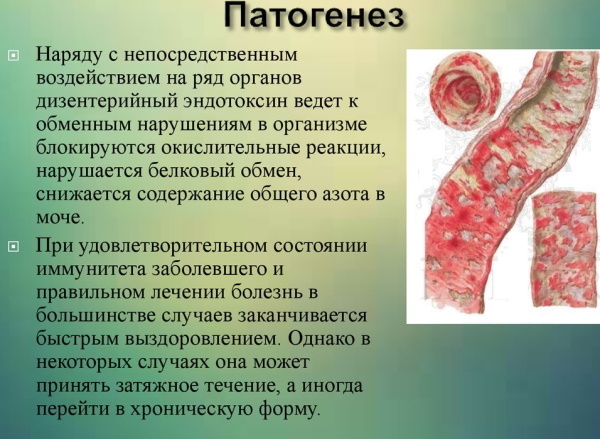
Treatment should be started in a timely manner, since the chronic form of dysentery leads to the development of severe disturbances in the functioning of the digestive tract, as well as organic changes in the mucous membrane intestines.
Convalescence period
During the recovery period, the integrity of the mucous membrane of the damaged intestine and colon is restored, and the inflammatory process takes place. The patient's stool normalizes, appetite and general well-being improve, and the intensity of the manifestation of abdominal pain decreases.
With a mild course of dysentery, the patient's condition improves by the end of the first week of treatment. If we are talking about a moderate form, then a significant improvement in general well-being can be felt after 2 weeks of complex therapy. In a severe course of an infectious disease, convalescence occurs at least 3-4 weeks after the first signs of dysentery appear.
Symptoms of atypical forms of dysentery
Abdominal pain with the rapid development of dysentery begins to bother the patient from the first day after infection with pathogens. If the disease proceeds in an erased form, then the patient has no signs of intoxication, there is no diarrhea, the body temperature is within normal limits. When examining the patient, the doctor determines a spasmodic sigmoid colon, as well as a weakening of the sphincter of the anus. Diagnosis of dysentery is carried out by a laboratory method.

Infants are often diagnosed with a mild infectious disease.
The main symptoms of the disease:
- Vomit.
- Loose stools.
- Poor appetite.
Only the analysis of feces helps to correctly diagnose.
High body temperature, limb cramps, discoordination and signs of the development of infectious-toxic shock are characteristic of the hypertoxic form of dysentery.
The patient's condition is rapidly deteriorating against the background of the following symptoms:
- Tachycardia.
- Decrease in blood pressure indicators to critical levels.
- Acrocyanosis. This is a bluish color of the skin associated with insufficient blood supply to small capillaries.
- Weakening of both heart sounds.
In world medical practice, a high rate of death of patients is annually recorded within the first 2-3 days after ingestion of shigella.
Features of dysentery in adults
In adult patients, infection can vary in severity. Dysentery is especially poorly tolerated by people who have various chronic diseases, immunodeficiency, and acute diseases. Pathogenic microorganisms of the genus Shigella are extremely dangerous for people over 65 and pregnant women.
Features of dysentery in children
In children under 5 years of age, infection with an infectious disease occurs through household contact (through dirty hands). The transmission of pathogenic microorganisms along with food is characteristic of older children. In newborns, rumbling of the sigmoid colon is rare.
The younger the child, the longer it takes for the affected colon to heal. More than 95% of children with dysentery are hospitalized and undergo drug treatment on an outpatient basis. In 55% of cases, an infectious lesion of the digestive tract is accompanied by a deterioration in the functioning of the central nervous system.
Where and how does the stomach hurt at different stages of dysentery development?
Dysentery develops rapidly. At the first stage, the patient develops a syndrome of general intoxication, which is characterized by nausea, vomiting, chills, headache attacks, hypotension and a feeling of heat in the body. With damage to the gastrointestinal tract, a dull pain occurs, which spreads throughout the abdomen and is permanent. In the absence of drug treatment, the pain becomes acute, cramping and localized in the lower abdomen.
Mild dysentery
Abdominal pain with mild dysentery is considered moderate and worse immediately before a bowel movement. Fever is short-term, as it lasts from 3 hours. up to 2 days.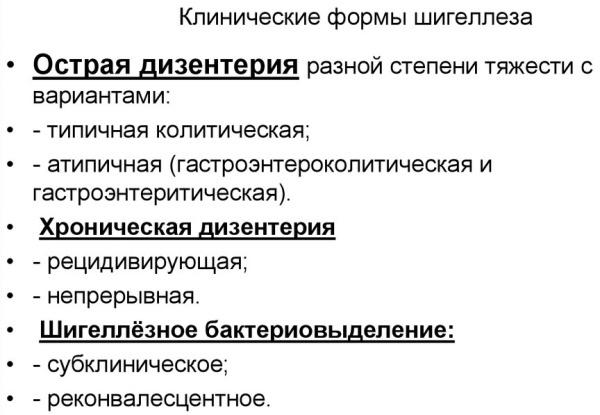 The body temperature rises to 38 C. The feces become more liquid, watery. The total number of bowel movements is within 12 times a day. Diarrhea worries the patient for 3 days. The patient's condition returns to normal in 1-4 weeks.
The body temperature rises to 38 C. The feces become more liquid, watery. The total number of bowel movements is within 12 times a day. Diarrhea worries the patient for 3 days. The patient's condition returns to normal in 1-4 weeks.
Moderate form
With a moderate form of dysentery, the patient experiences sharp pains in the lower abdomen, often recurring tenesmus. Stool frequency can be up to 24 times a day. The bowel movements are minor, may consist exclusively of bloody streaks and mucus.
Body temperature can rise to 39 C. The patient's condition is rapidly deteriorating against the background of dizziness, general malaise, migraine and poor appetite. Excessive irritability, cyanosis is not excluded. Tongue dry, covered with a white coating. Diarrhea, as well as other symptoms of intoxication, disturb the patient for 5 days. The condition of the mucous membrane of the large intestine is restored in 1.5-2 months.
Severe form
Abdominal pain in severe dysentery is acute, accompanied by frequent urge to urinate, defecate. 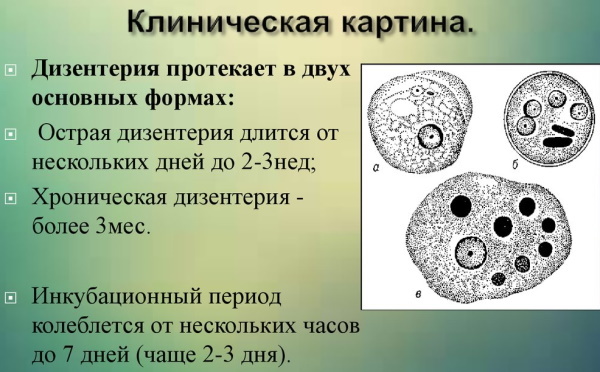 An infectious disease is characterized by severe intoxication and the occurrence of significant disturbances in the work of the cardiovascular system. The body temperature rises rapidly to 40 C. Recovery takes at least 2-3 months. Completely the mucous membrane of the large intestine is restored only after 60-80 days.
An infectious disease is characterized by severe intoxication and the occurrence of significant disturbances in the work of the cardiovascular system. The body temperature rises rapidly to 40 C. Recovery takes at least 2-3 months. Completely the mucous membrane of the large intestine is restored only after 60-80 days.
Extremely severe form
This form of dysentery is quite rare. Infectious pathology is accompanied by severe abdominal pain. In severe dysentery, the large intestine undergoes a total necrotic ulcerative lesion. In 90% of cases, complications arise: encephalopathy, septic shock. The patient has severe grade III-IV dehydration. The body temperature rises to 41 C. Frequent stools, chills, muscle weakness. The prognosis for the patient is unfavorable.
How to relieve pain during illness with drugs?
Abdominal pain with dysentery can be quickly eliminated with the help of medicines that must be prescribed by an infectious disease specialist. It is recommended to start drug therapy with the use of antibiotics, which are indicated for any form of infectious disease.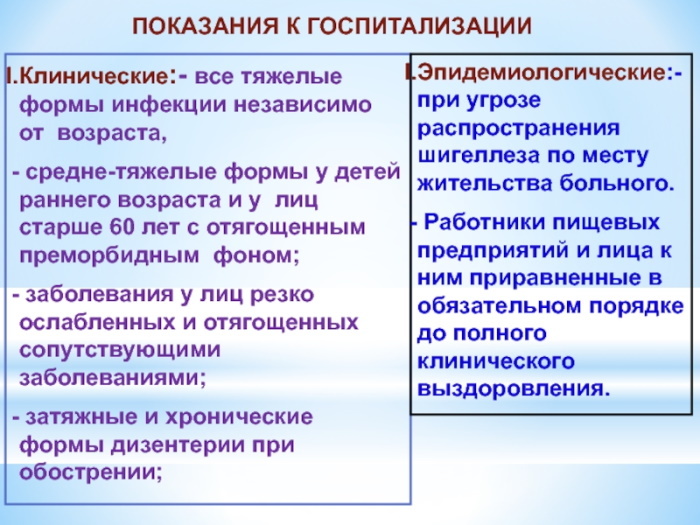
The drugs of the cephalosporin and fluoroquinolone series, which are prescribed for 1 week, are most effective. Treatment should be supervised by your doctor. It is strictly forbidden to take antibiotics for longer than the prescribed period, as otherwise antibiotic resistance will arise.
To relieve spasm and eliminate pain, it is recommended to take antispasmodics. With hemorrhagic syndrome, Heparin is highly effective. The patient is shown to drink plenty of saline solutions. For example, Philips, Regidron, Gastrolit. You can cope with nausea and vomiting with the help of parenteral administration of special solutions: Acesol, Trisol.
Enterosorbents should be used for the first 3 days of complex treatment of dysentery. In case of rapid fluid loss due to diarrhea, it is recommended to use medications to prevent increased fluid secretion into the intestinal lumen. Probiotics, as well as pancreatic enzymes, will help normalize the gastrointestinal microflora.
| Disease form | Drug name | Recommended dosage |
| Mild dysentery | Furazolidone | 0.1 g 3-4 times a day |
| Co-trimoxazole | 2 tablets in the morning and in the evening | |
| Ersefuril | 0.2 g 4 times a day | |
| Moderate form of dysentery | Ofloxacin | 0.2 g 2 times a day |
| Co-trimoxazole | 2 tablets in the morning and in the evening | |
| Intetrix | Maximum 3 times a day, 2 tablets | |
| Ciprofloxacin | 0.25 g in the morning and in the evening | |
| Severe dysentery | Ofloxacin | 0.4 g 2 times a day |
| Ciprofloxacin | 0.5 g in the morning and in the evening | |
| Levomycetin | 0.5 g 4 times a day | |
| Tetracycline | 0.3 g 4 times a day |
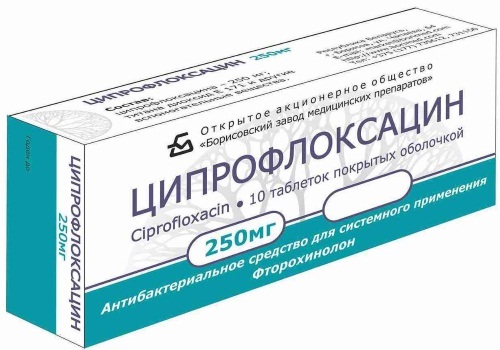 Discharge of patients is carried out only if the general clinical picture has returned to normal. Indicators of general laboratory blood and urine tests should improve. Specialists carry out a single negative fecal test using the bacteriological culture method, but not earlier than 2 days after the completion of antibiotic therapy. Additionally, doctors carry out dispensary observation of the patient within 3 months after discharge.
Discharge of patients is carried out only if the general clinical picture has returned to normal. Indicators of general laboratory blood and urine tests should improve. Specialists carry out a single negative fecal test using the bacteriological culture method, but not earlier than 2 days after the completion of antibiotic therapy. Additionally, doctors carry out dispensary observation of the patient within 3 months after discharge.
Traditional methods of pain relief, home remedies recipes
It is possible to use recipes for decoctions from traditional medicine to eliminate pain syndrome with dysentery only in combination with the regular use of medications. You must first consult with an infectious disease specialist in order to exclude the likelihood of adverse reactions and to avoid further progression of the disease.
The following decoctions will help to eliminate abdominal pain with an infectious lesion of the gastrointestinal tract:
- You need to take 1 tbsp. l. fruits of bird cherry and pour 250 ml of boiling water over them. The product must be boiled for 5 minutes, then removed from the heat and allowed to brew for 1 hour. It is recommended to take a pre-strained broth, 70 ml 3-4 times a day.
- Burnet root has a good anti-inflammatory, analgesic, astringent and bactericidal principle of action. You need to take 1 tbsp. l. finely chopped root and pour 250 ml of hot water over it. It is necessary to boil the product for 20 minutes. over low heat, and after cooling, drain. Take the broth should be 1 tbsp. l. maximum 6 times a day.
- A decoction of ash bark helps to cope with dysentery. You can use not only young bark, but also the ends of ash branches. You need to take 500 g of bark and pour 1 glass of hot water over it. The product must be boiled under a closed lid over low heat for 20 minutes. The cooled broth is recommended to take 35 g in the morning, at lunchtime and in the evening.
Only with the right combination of medicinal decoctions from traditional medicine with medications can you not only eliminate abdominal pain, but also speed up recovery. Safe combination therapy can only be prescribed by a qualified physician.
Features of the regimen and diet to alleviate the condition
It is possible to improve the patient's condition and speed up recovery with the help of special diet therapy. If an acute stage of an infectious disease is diagnosed, then it is necessary to adhere to a diet prepared by the attending physician, eating foods with a minimum amount of fat and carbohydrates. It is recommended to take food in small portions 5-6 times a day. You also need to avoid foods that cause bloating.
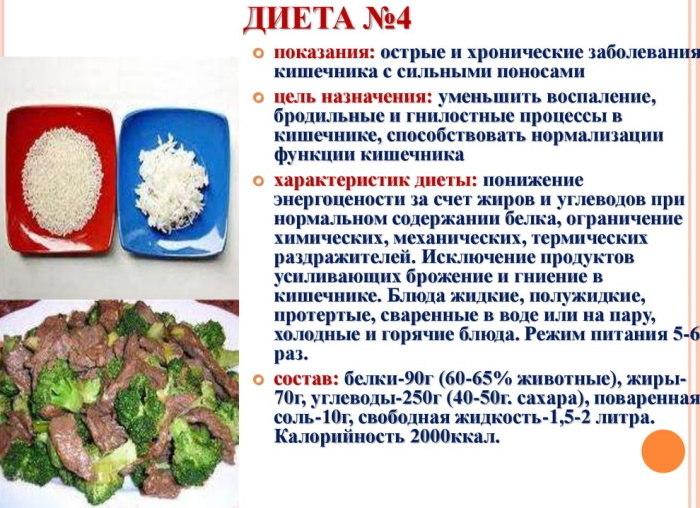
| Recommended food, drinks | Prohibited foods, drinks |
| Water-cooked porridge (e.g. rice, oatmeal) | Flour products |
| Mashed vegetable soups | Wheat and pearl barley porridge |
| Soft-boiled eggs, omelet | Fresh bread |
| Boiled lean fish, meat | Sausage |
| White bread croutons | Fatty meats |
| Fish soups | Rich broths |
| Acidophilus milk and paste | Salty fish |
| Calcined pureed cottage cheese | Coffee |
| Weak green tea | Peas, beans |
| Rosehip decoction | Compotes |
| Butter (for 1 portion no more than 5 g) | Jam |
| Blueberry, bird cherry jelly | Sweet fruits, fresh vegetables |
| Fruits rich in tannins | Milk |
With a timely appeal to an infectious disease specialist and strict adherence to the prescribed therapy, the likelihood of complications is 1%.
For the speedy recovery of the body at the stage of recovery, adults and children are prescribed a reception vitamins, decoctions from medicinal plants and medications to increase protective functions immunity. Medicines in combination with diet help eliminate abdominal pain, normalize stool and significantly improve the general condition of dysentery.
It is strictly forbidden to self-medicate, as this is fraught with the emergence of an internal bleeding, dehydration, wasting, chronic renal failure, and prolapse rectum. In severe cases, the death of the patient is not excluded.
Dysentery video
Malysheva on how not to get sick with dysentery:


